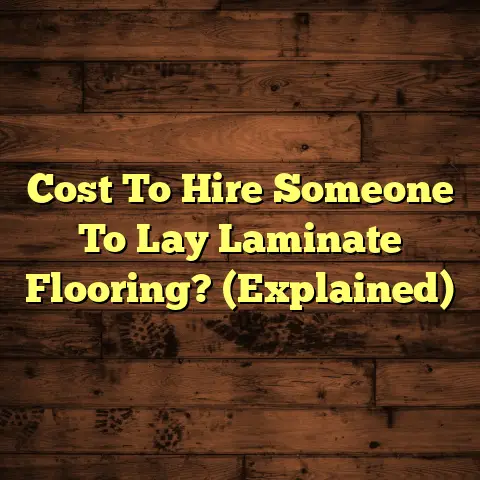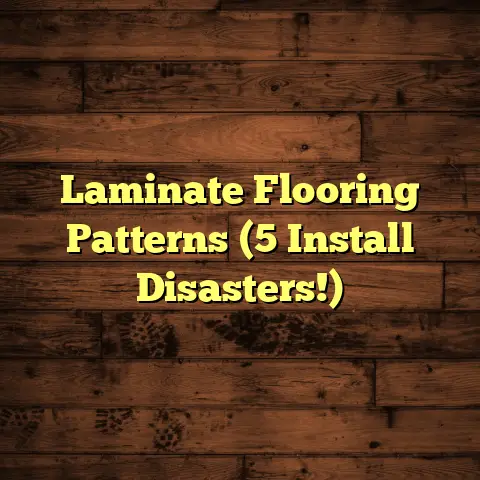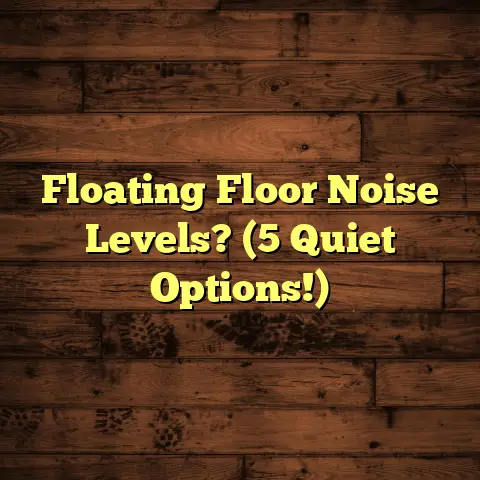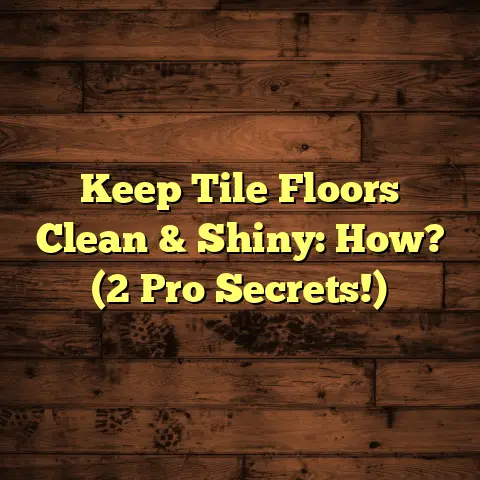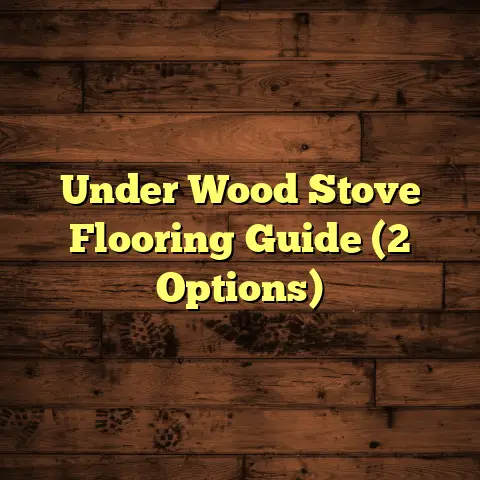New Bath Flooring Cost? (2-Day Budget Busters!)
I get it. As a flooring contractor with years of experience, I’ve seen it all. And I know the frustration of wanting a bathroom that’s both beautiful and functional.
That’s why we’re diving into bathroom flooring replacement. Specifically, how to do it quickly and affordably. Think “2-Day Budget Busters!” We’re gonna break down the costs, the options, and how to make it happen without breaking the bank. Ready? Let’s get started!
Understanding the Importance of Bathroom Flooring
Okay, so why is bathroom flooring such a big deal? It’s more than just aesthetics. Think about it: your bathroom is a wet zone. Steam from showers, splashes from the sink… Your flooring needs to handle it all.
Moisture resistance is key. You don’t want something that’s going to warp, rot, or grow mold. Durability is also crucial. Bathrooms see a lot of foot traffic.
And let’s not forget maintenance! Nobody wants flooring that’s a pain to clean. The right flooring can transform your bathroom, making it feel like a spa retreat instead of a dingy dungeon.
According to a recent survey by the National Association of Home Builders (NAHB), homeowners consistently rank bathroom renovations among their top priorities. https://www.nahb.org/ That’s because a well-designed bathroom can significantly increase your home’s value and your own enjoyment.
I remember one client, Sarah, who had hideous old linoleum in her bathroom. It was peeling and stained, and honestly, it made the whole room feel depressing. After we installed some beautiful porcelain tile, she told me it felt like she’d added an entire room to her house! It completely changed the vibe.
Types of Bathroom Flooring Options
Alright, let’s get into the nitty-gritty. What are your options for bathroom flooring? Here’s a rundown:
-
Ceramic and Porcelain Tiles: These are classics for a reason. They’re waterproof, durable, and come in a ton of styles. You can find everything from sleek modern designs to rustic, textured looks. Cost-wise, you’re looking at roughly $3-$10 per square foot for the materials, plus another $5-$14 per square foot for installation. Installation can take 1-3 days, depending on the size of your bathroom and the complexity of the pattern.
-
Vinyl Flooring: This is your budget-friendly champion. Vinyl comes in sheets, tiles, and planks, and it’s incredibly water-resistant. It’s also relatively easy to install yourself, which can save you a lot of money. You can score vinyl for around $1-$5 per square foot. Installation costs are minimal if you DIY, or around $2-$7 per square foot if you hire a pro. A small bathroom could be done in a single day!
-
Natural Stone: Marble, granite, slate… these are the luxury options. They’re gorgeous and add a serious touch of elegance. But be warned: they’re also pricey and can be more porous than other materials, requiring sealing. Expect to pay $8-$30+ per square foot for the materials, and $5-$15+ per square foot for installation. Installation can be time-consuming, potentially taking 2-4 days.
-
Laminate Flooring: While not ideal for high-moisture areas, laminate can work in bathrooms if you choose a water-resistant variety and take extra precautions to seal the edges. It’s affordable, typically costing $1-$5 per square foot for materials and $2-$8 per square foot for installation. Installation is relatively quick, often done in a day or two.
-
Luxury Vinyl Tiles (LVT): LVT is like the upgraded version of vinyl. It’s designed to mimic the look of real wood or tile, and it’s incredibly durable and waterproof. You’ll pay more than standard vinyl, around $2-$7 per square foot for materials and $3-$10 per square foot for installation. Installation is similar to vinyl, often achievable in a day or two.
To give you a clearer picture, here’s a quick cost comparison:
| Flooring Type | Material Cost (per sq ft) | Installation Cost (per sq ft) | Total Cost (per sq ft) | Installation Time (approx.) |
|---|---|---|---|---|
| Ceramic/Porcelain Tile | $3 – $10 | $5 – $14 | $8 – $24 | 1-3 days |
| Vinyl Flooring | $1 – $5 | $2 – $7 | $3 – $12 | 1 day |
| Natural Stone | $8 – $30+ | $5 – $15+ | $13 – $45+ | 2-4 days |
| Laminate Flooring | $1 – $5 | $2 – $8 | $3 – $13 | 1-2 days |
| Luxury Vinyl Tile (LVT) | $2 – $7 | $3 – $10 | $5 – $17 | 1-2 days |
Note: These are just averages. Actual costs can vary depending on your location, the specific product you choose, and the contractor you hire.
Breakdown of Installation Costs
So, you’ve picked your flooring. Now, let’s talk installation. This is where costs can really fluctuate.
-
Labor Costs vs. DIY Options: Hiring a professional guarantees a quality installation. They have the experience and tools to do the job right. But, labor can be a significant expense, often ranging from $5-$15+ per square foot. DIYing can save you money, but it requires time, effort, and some skill. If you’re not confident in your abilities, it’s best to leave it to the pros. Trust me, I’ve seen some DIY disasters that ended up costing more to fix than hiring a contractor in the first place!
-
Preparation Work: Before you can even lay the new flooring, you need to prep the subfloor. This might involve removing the old flooring, leveling the floor, and repairing any damage. Floor leveling can add $1-$3 per square foot to the cost, and old flooring removal can be another $1-$5 per square foot.
-
Additional Materials: Don’t forget about the extras! You’ll need underlayment (especially for laminate and some vinyl), adhesives, grout (for tile), and tools. These can add a few hundred dollars to your project, depending on the size of your bathroom.
Here’s a more detailed breakdown of potential installation costs:
| Cost Category | Description | Average Cost (per sq ft) |
|---|---|---|
| Old Flooring Removal | Removing existing flooring (tile, vinyl, etc.). Includes disposal fees. | $1 – $5 |
| Subfloor Preparation | Leveling the subfloor (using self-leveling compound or plywood), repairing cracks or damage. | $1 – $3 |
| Underlayment | Installing underlayment (foam, cork, etc.) to provide cushioning, sound insulation, and moisture barrier. | $0.50 – $2 |
| Adhesives/Mortar | Cost of adhesives or mortar used to secure the flooring to the subfloor. | $0.50 – $2 |
| Grout (for Tile) | Cost of grout used to fill the gaps between tiles. Includes sealing. | $0.50 – $2 |
| Labor (Professional) | Hiring a professional installer. Includes their hourly rate and any additional fees. | $5 – $15+ |
| Tools (DIY) | Cost of tools needed for DIY installation (saw, trowel, measuring tape, etc.). This is a one-time cost if you don’t already own the tools. | Varies |
| Waste Disposal | Cost of disposing of construction waste (old flooring, packaging, etc.). | $50 – $200 (flat fee) |
Budgeting for Bathroom Flooring
Okay, let’s get real about budgeting. This is where a lot of people get tripped up. The key is to be realistic and plan ahead.
First, figure out your absolute maximum budget. This is the most you can possibly spend without causing financial stress. Then, research different flooring options and get quotes from multiple contractors. Don’t just go with the first quote you get!
Prioritize your spending. Do you want to splurge on high-end tile and save on installation by DIYing? Or are you willing to go with a more budget-friendly flooring option to afford professional installation?
Always, always account for unexpected costs. There’s almost always something that comes up during a renovation project. Add a buffer of at least 10-15% to your budget to cover these surprises.
Here’s a sample budget template you can adapt:
Bathroom Flooring Budget Template
- Total Budget: \$[Enter Amount]
- Flooring Material:
- Type: [e.g., Vinyl, Tile, LVT]
- Cost per sq ft: \$[Enter Amount]
- Total Material Cost: \$[Enter Amount]
- Installation:
- Labor Cost (if applicable): \$[Enter Amount]
- DIY Cost (Tools, etc.): \$[Enter Amount]
- Preparation:
- Old Flooring Removal: \$[Enter Amount]
- Subfloor Repair/Leveling: \$[Enter Amount]
- Additional Materials:
- Underlayment: \$[Enter Amount]
- Adhesives/Grout: \$[Enter Amount]
- Sealer (if applicable): \$[Enter Amount]
- Miscellaneous:
- Permits (if required): \$[Enter Amount]
- Waste Disposal: \$[Enter Amount]
- Contingency (10-15%): \$[Enter Amount]
- Total Estimated Cost: \$[Enter Amount]
Remember, this is just a template. Adjust it to fit your specific needs and circumstances.
Case Studies: Real-Life Bathroom Flooring Projects
Let’s look at some real-life examples to see how these costs play out:
-
Case Study 1: The Budget Vinyl Makeover
- Homeowner: John
- Bathroom Size: 50 sq ft
- Flooring Choice: Sheet Vinyl
- Budget: \$500
- Project Details: John ripped out the old linoleum himself, prepped the subfloor with some patching compound, and installed sheet vinyl. He spent around $200 on the vinyl and $50 on supplies. The whole project took him a weekend and came in well under budget.
-
Case Study 2: The LVT Upgrade
- Homeowner: Maria
- Bathroom Size: 60 sq ft
- Flooring Choice: Luxury Vinyl Tile (LVT)
- Budget: \$1200
- Project Details: Maria wanted a more upscale look, so she chose LVT that resembled wood planks. She hired a professional installer, which cost her around $400. The LVT itself cost around $600, and the remaining $200 went to underlayment and other supplies. The project was completed in two days.
-
Case Study 3: The Tile Transformation
- Homeowner: David
- Bathroom Size: 40 sq ft
- Flooring Choice: Porcelain Tile
- Budget: \$1500
- Project Details: David wanted a durable and stylish option, so he opted for porcelain tile. He hired a contractor to remove the old tile, level the floor, and install the new tile. The labor cost was around $700, and the tile itself cost around $600. The remaining $200 went to grout, sealer, and other supplies. The project took three days to complete.
These case studies show that you can achieve a beautiful bathroom floor within a reasonable budget, depending on your choices and your willingness to DIY.
Conclusion: The Value of Investing in Quality Flooring
So, we’ve covered a lot of ground. We’ve talked about the importance of bathroom flooring, the different options available, the costs involved, and how to create a realistic budget.
The key takeaway is that investing in quality flooring is worth it. It not only enhances the look and feel of your bathroom, but it also adds value to your home and improves your overall quality of life.
Sure, you could go with the cheapest option and save a few bucks upfront. But in the long run, you’ll likely end up paying more to repair or replace it sooner.
Don’t be afraid to take the plunge and transform your bathroom with new flooring. With careful planning and a little bit of elbow grease, you can achieve a stunning result without breaking the bank. Remember those “2-Day Budget Busters!” mindset.
So, what are you waiting for? Get started on your bathroom flooring project today!

